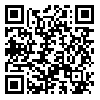Volume 13, Issue 3 (7-2009)
IBJ 2009, 13(3): 179-183 |
Back to browse issues page
Download citation:
BibTeX | RIS | EndNote | Medlars | ProCite | Reference Manager | RefWorks
Send citation to:



BibTeX | RIS | EndNote | Medlars | ProCite | Reference Manager | RefWorks
Send citation to:
Mansouri K, Mostafaei A, Mirshahi M, Mohammadi Motlagh H, Maleki A, Keshavarz M. Human Coagulated Plasma as a Natural and Low Cost Matrix for in vitro Angiogenesis. IBJ 2009; 13 (3) :179-183
URL: http://ibj.pasteur.ac.ir/article-1-69-en.html
URL: http://ibj.pasteur.ac.ir/article-1-69-en.html
Kamran Mansouri * 
 , Ali Mostafaei
, Ali Mostafaei 
 , Manochehr Mirshahi
, Manochehr Mirshahi 
 , Hamidreza Mohammadi Motlagh
, Hamidreza Mohammadi Motlagh 
 , Ali Maleki
, Ali Maleki 
 , Maryam Keshavarz
, Maryam Keshavarz 


 , Ali Mostafaei
, Ali Mostafaei 
 , Manochehr Mirshahi
, Manochehr Mirshahi 
 , Hamidreza Mohammadi Motlagh
, Hamidreza Mohammadi Motlagh 
 , Ali Maleki
, Ali Maleki 
 , Maryam Keshavarz
, Maryam Keshavarz 

Abstract:
Background: Angiogenesis, the development of new blood vessels, is an important process in tissue development and wound healing, but becomes pathologic when associated with solid tumor growth, proliferative retinopathies, and rheumatoid arthritis. Accurate and reliable qualification of neovascular (angiogenic) response, both in vitro and in vivo, is an essential requirement for the study of new blood vessel growth. The complexity of currently used three-dimensional in vitro angiogenesis systems makes it difficult to approve material in its models. Capillary-like structure occurs on basement membrane components such as collagen and/or laminin, while in other models, CLS formation occurs on transitional matrices such as fibrin. To solve this problem, we were interested in developing an angiogenesis system which allows rapid and reliable quantification of three-dimensional neovessel formation in vitro. Methods: Human bone marrow endothelial cells were seeded on gelatin-coated microcarriers and suspended in a solution of platelet-poor plasma which was induced to polymerize by addition of calcium chloride. In this way, microcarriers were entrapped in three-dimensional coagulated plasma. Results: Within a few hours, endothelial cells begin to leave these supporting microcarries and migrate into the coagulated-plasma matrix and formed CLS within 48-72 hours. Conclusion: We developed a convenient angiogenesis in vitro system which allows reliable quantification of capillary formation in a three-dimensional environment.
Type of Study: Full Length/Original Article |
Subject:
Related Fields
| Rights and permissions | |
 |
This work is licensed under a Creative Commons Attribution-NonCommercial 4.0 International License. |






.png)
